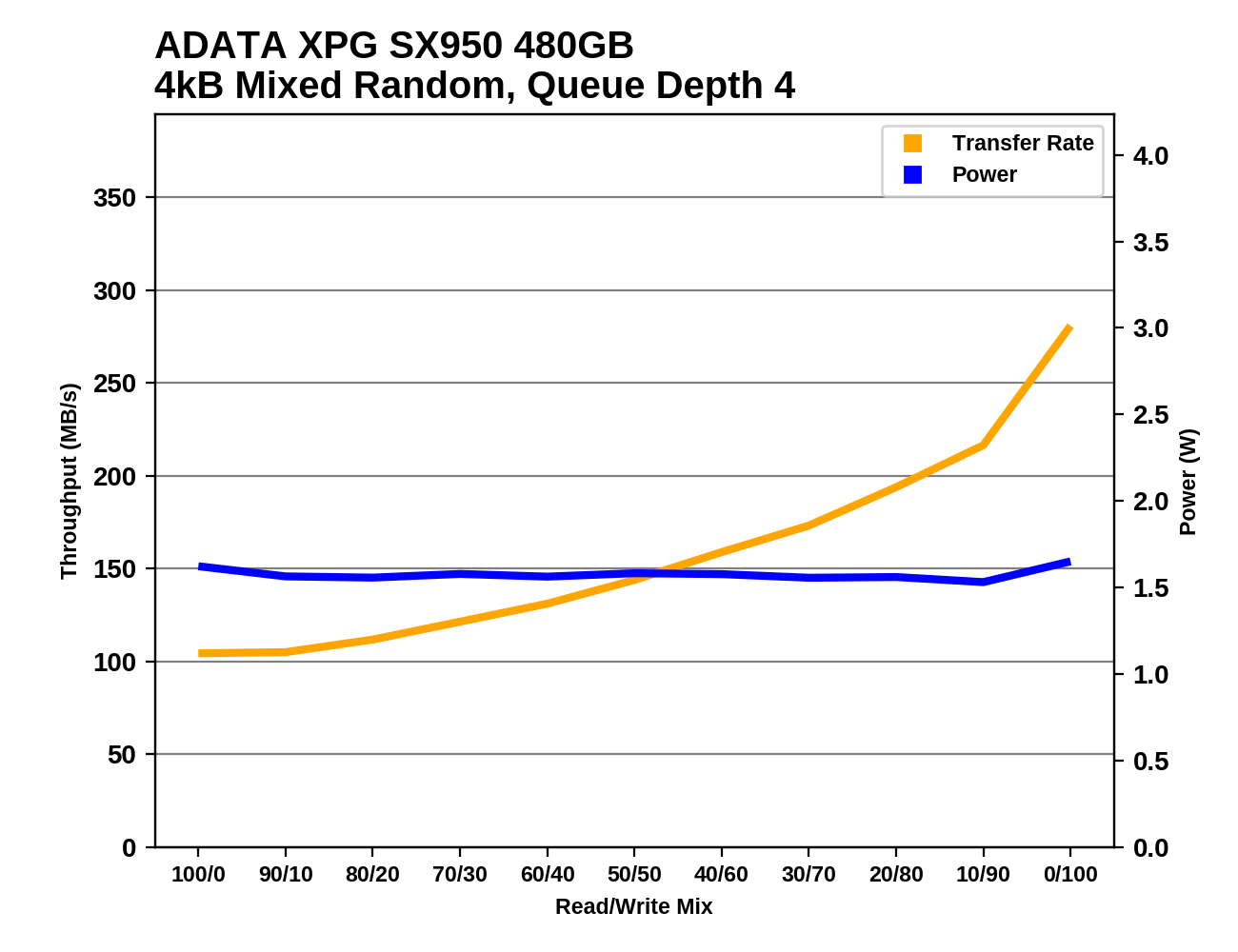The ADATA XPG SX950 480GB SSD Review: In Search of Premium
by Billy Tallis on October 9, 2017 8:00 AM ESTMixed Random Performance
Our test of mixed random reads and writes covers mixes varying from pure reads to pure writes at 10% increments. Each mix is tested for up to 1 minute or 32GB of data transferred. The test is conducted with a queue depth of 4, and is limited to a 64GB span of the drive. In between each mix, the drive is given idle time of up to one minute so that the overall duty cycle is 50%.

The overall performance of the ADATA XPG SX950 on the mixed random I/O test is just a bit average, and about 20% slower than Samsung's SATA drives.

The power efficiency of the SX950 looks a bit better, but the Samsung 850 EVO managed to tie for first place on performance wile holding a substantial lead on power efficiency. The SX950 does hold a slight efficiency advantage over the Samsung 850 PRO on this test.
 |
|||||||||
The SX950's power consumption is very flat across the varying workloads of this test, while the performance improves steadily as the share of writes grows. The top-performing Samsung drives start out about 40MB/s faster than the SX950 and most drives show a more significant performance spike when they reach the all-writes phase of the test.
Mixed Sequential Performance
Our test of mixed sequential reads and writes differs from the mixed random I/O test by performing 128kB sequential accesses rather than 4kB accesses at random locations, and the sequential test is conducted at queue depth 1. The range of mixes tested is the same, and the timing and limits on data transfers are also the same as above.

The mixed sequential I/O performance of the ADATA XPG SX950 is sub-par, though there are actually three planar MLC SSDs that are even slower. The Crucial BX300 is about 14% faster overall.

The SX950's efficiency is tied with the Crucial BX300, and both are near the top of the chart. The DRAMless OCZ VX500 is far more efficient that the rest of these drives, and without it the SX950's efficiency score would look very good.
 |
|||||||||
During the first half of this test as the proportion of writes grows, the SX950's performance increases and the power consumption drops. During the second half, the improvement falters but neither performance nor power consumption regress significantly. The Crucial BX300 is faster across the board, especially during the read-heavy parts of the test, but it requires significantly more power to deliver that higher read performance.










45 Comments
View All Comments
Cliff34 - Monday, October 9, 2017 - link
It is almost for almost all your needs, budget or performance, better stick with Samsung's SSDs.Chaitanya - Monday, October 9, 2017 - link
Sadly Adata has diarrhea when it comes to releasing SSDs. They drop too many SSDs on market too fast.chrnochime - Tuesday, October 10, 2017 - link
You!= everyone under the sun. And no not everyone wants to be stuck with a freakin TLC SSD, as much as you'd like to believe. How hard can that be to grasp? Wait rhetorical question LOLDr. Swag - Monday, October 9, 2017 - link
Is ADATA out of their minds? This drive performs on the budget end of the spectrum yet they're pricing it above the 850 pro?!?jardows2 - Monday, October 9, 2017 - link
Before I read the article, I thought I knew the conclusion - It will perform under Samsung products, and be priced a bit too high for the comparative performance. I guess I was highly optimistic about this drive! What is up with that price?Flunk - Monday, October 9, 2017 - link
ADATA's pricing is truely perplexing. Maybe their market is "people who don't read SSD reviews", so they think they can write "premium" on the box and it justifies the price. Maybe they're pricing just so they can have it 50% off MSRP all the time. Regardless, I'd argue there isn't really such thing as a premium SATA SSD anymore because even budget NVMe drives throttle them.4x PCI-E 3.0 is 32Gbps, Fully 4 times the bandwidth of SATA 3. That's not a generational leap, it's a whole new ballgame, especially if you consider the reduction in overhead that comes with NVMe. SATA drives are now relegated to being upgrades for older desktops and notebooks, there is no "high-end" left.
ddriver - Monday, October 9, 2017 - link
sata 3 is 6 gbits, IIRC 6 * 4 is 24Also, 4 times faster drive doesn't make a system 4 times faster. It is true that before SSDs, storage was pretty much the bottleneck, but if you look at real world benchmarks, the difference between a SATA and a NVME SSD is a few percents in 99% of the cases.
xeroshadow - Monday, October 9, 2017 - link
I can attest to this. I went from an Intel 330 series to NVMe Samsung 960 and barely noticed any difference except in some launch speeds of certain programs. I was disappointed.Samus - Monday, October 9, 2017 - link
It's like CPU's. Programs just haven't caught up to their capability yet. Other than mass data transfer (between SSD's no less) you are likely to see any real-world performance boost from NVMe over SATA3. Decompressing is the only area I personally benefit from NVMe; it unRAR's files much faster than a SATA3 drive.But gaming, general usage, and even content creation I don't notice a difference.
saratoga4 - Monday, October 9, 2017 - link
It's because while the transfer rate of high end NVMe drives is much higher, that really doesn't help you load a few dozen 10 MB files all that much faster. For lots of small to medium sized files, you need lower access latency, and NVME drives are little better than SATA, so until that improves the main place NVME will have an edge is copying files between NVME drives.